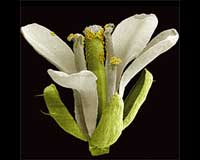 |
Frostburg MD (SPX) Nov 16, 2010 A new analysis of fossilized grass-pollen grains deposited on ancient European lake and sea bottoms 16-35 million years ago reveals that C4 grasses evolved earlier than previously thought. This new evidence casts doubt on the widely-held belief that the rise of this incredibly productive group of plants was driven by a large drop in atmospheric carbon dioxide concentrations during the Oligocene epoch. The research team, led by University of Maryland Center for Environmental Science Appalachian Laboratory researcher Dr. David Nelson and University of Illinois Professor Feng Sheng Hu, examined the carbon isotope signatures of hundreds of grass-pollen grains and found that C4 grasses were already present on the landscape during the early part of the Oligocene, some 14 million years earlier than previously thought from geological evidence. Their findings are now published online in the journal Geology and will shortly appear in the print edition. "The idea that C4 grasses originated prior to global decreases in carbon dioxide levels requires us to reevaluate the way we think about the evolution of C4 photosynthesis," said Dr. Nelson. "This new information should encourage the examination of alternate evolutionary selection pressures, such as warm temperatures or dry climates." C4 plants compose only 3 percent of flowering plant species, yet account for about 25 percent global terrestrial productivity. About 60% of C4 species are grasses, and they dominate the world's grassland and savanna biomes, particularly those in warmer, lower latitude areas. Their ecological success results from the way these species concentrate and then fix carbon dioxide in order to power photosynthesis. While the most well known C4 plants are maize and sugar cane, both of which are critical to human consumption, there is a growing interest in their use as biofuels in order to capture carbon from the atmosphere to mitigate increasing global carbon dioxide levels. The team used an innovative technique pioneered by Dr. Nelson earlier in his career - the Single Pollen Isotope Ratio Analysis or SPIRAL - to analyze the samples. The scientists first extracted grains of grass pollen from sedimentary rocks using a micromanipulator; then analyzed the tiny samples using a microcombustion device interfaced with an isotope ratio mass spectrometer in Ann Pearson's laboratory at Harvard University, which houses one of only a handful of these devices in the world. Through this analysis, they were able to detect the signature of C4 species from their more common C3 counterparts, because C4 and C3 plants take up different ratios of carbon isotopes during photosynthesis. "SPIRAL enables us to detect C4 grasses at much lower abundances in geological records than previous approaches, which is helping to revolutionize our ability to study their ecology and evolution," said Dr. Hu. University of Illinois graduate student Michael Urban, lead author of the paper, continues to analyze samples from other parts of the world to look at variation in C4-grass abundance in relation to past changes in atmospheric CO2 and climate. The article, "Isotopic evidence of C4 grasses in southwestern Europe during the Early Oligocene-Middle Miocene" is online at http://geology.gsapubs.org/content/early/2010/10/05/G31117.1.abstract . This research was supported by University of Illinois Research Board, National Science Foundation and the David and Lucille Packard Foundation Fellowships Program.
Share This Article With Planet Earth
Related Links University of Maryland Center for Environmental Science Farming Today - Suppliers and Technology
 Change In Temperature Uncovers Genetic Cross Talk In Plant Immunity
Change In Temperature Uncovers Genetic Cross Talk In Plant ImmunityColumbia MO (SPX) Nov 16, 2010 Like us, plants rely on an immune system to fight off disease. Proteins that scout out malicious bacterial invaders in the cell and communicate their presence to the nucleus are important weapons in the plant's disease resistance strategy. Researchers at the University of Missouri recently "tapped" into two proteins' communications with the nucleus and discovered a previously unknown level ... read more |
|
| The content herein, unless otherwise known to be public domain, are Copyright 1995-2010 - SpaceDaily. AFP and UPI Wire Stories are copyright Agence France-Presse and United Press International. ESA Portal Reports are copyright European Space Agency. All NASA sourced material is public domain. Additional copyrights may apply in whole or part to other bona fide parties. Advertising does not imply endorsement,agreement or approval of any opinions, statements or information provided by SpaceDaily on any Web page published or hosted by SpaceDaily. Privacy Statement |